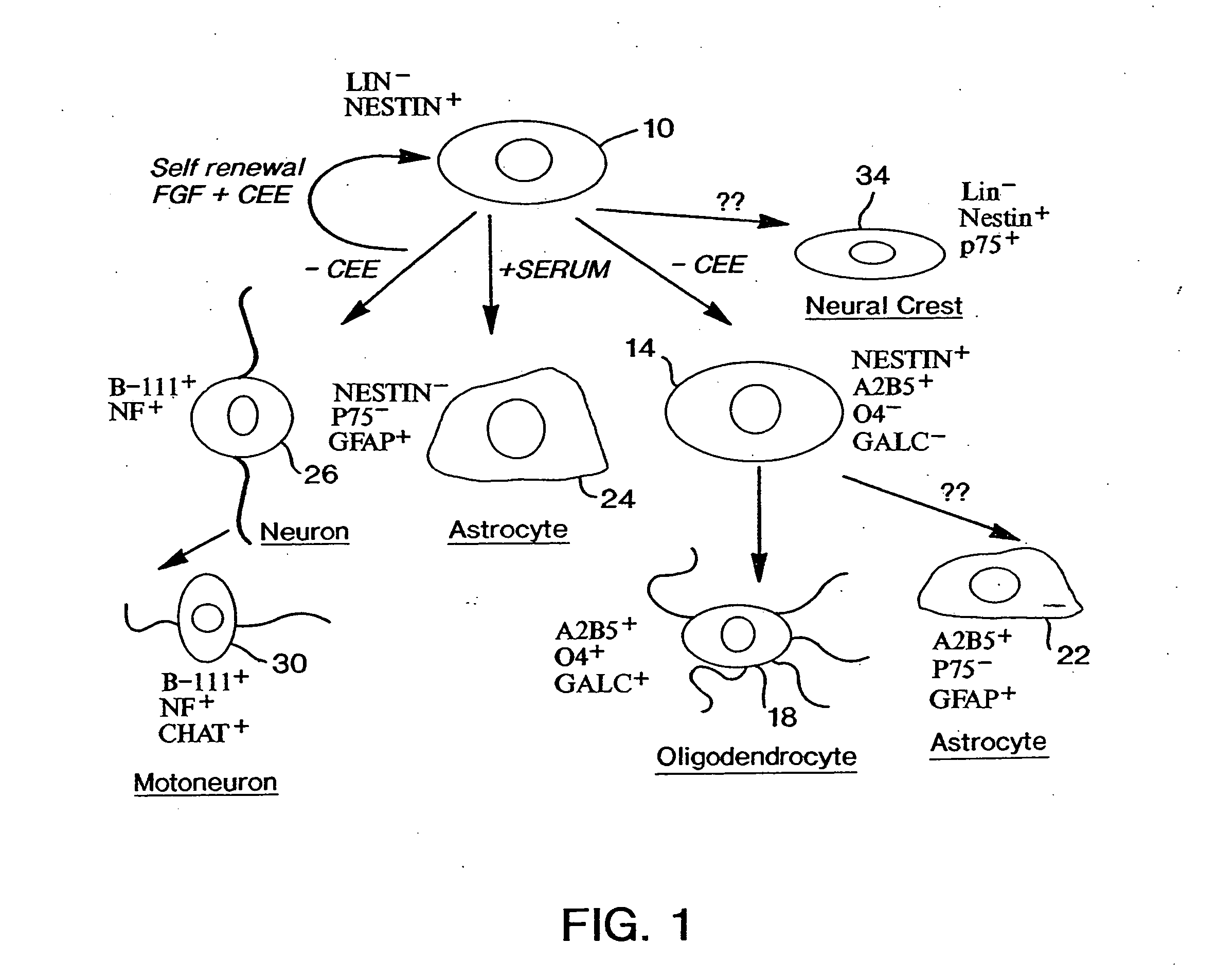Generation, characterization, and isolation of neuroepithelial stem cells and lineage restricted intermediate precursor
a neuroepithelial stem cell and lineage restriction technology, applied in the field of multipotent neuroepithelial stem cells and lineage restriction intermediate precursor cells, can solve the problems of insufficient fgf itself failure to disclose cultured nep cells, and insufficient fgf for long-term growth of neurospheres. , to achieve the effect of generating, isolating and culturing
- Summary
- Abstract
- Description
- Claims
- Application Information
AI Technical Summary
Benefits of technology
Problems solved by technology
Method used
Image
Examples
example 1
[0052] The neural tube undergoes closure at embryonic day 10 in rats, Hamburger, supra, and earliest differentiation occurs a day later, Hamburger, supra; Nornes & Das, supra; Altman & Bayer, supra. Embryonic day 10.5 (E10.5) therefore represents the earliest time point when a large number of undifferentiated NEP cells can be easily isolated. Sprague Dawley rat embryos were removed at E10.5 (13-22 somites) and placed in a petri dish containing Ca / Mg-free Hanks balanced salt solution (HBSS, GIBCO / BRL). The trunk segments of the embryos (last 10 somites) were dissected using tungsten needles, rinsed, and then transferred to fresh HBSS. Trunk segments were incubated at 4° C. in 1% trypsin solution (GIBCO / BRL) for a period of ten to twelve minutes. The trypsin solution was replaced with fresh HBSS containing 10% fetal bovine serum (FBS, GIBCO / BRL). The segments were gently triturated with a Pasteur pipette to release neural tubes free from surrounding somites and connective tissue. Isol...
example 2
[0053] E10.5 rat neural tube cells were dissociated according to the procedure of Example 1 except that the cells were plated at low density and incubated in NEP medium with either acidic FGF (aFGF; 25 ng / ml), basic FGF (bFGF; 25 ng / ml), epidermal growth factor.(EGF; 50 ng / ml) or no added factor for 48 hours. Cultured cells were fixed and examined by phase contrast microscopy according to methods well known in the art. Cells grown in aFGF or bFGF survived and increased in density. In contrast, no surviving cells were seen in cultures grown without FGF or with 50 ng / ml EGF. Thus, NEP cells require FGF for survival, and EGF does not support growth of NEP cells in adherent culture.
example 3
[0054] In this example, E10.5 rat neural tube cells were dissociated according to the procedure of Example 1, and equal numbers of cells were plated at low density in a 35 mm dish and incubated in NEP medium containing bFGF (25 ng / ml) with 10% CEE or without CEE for 5 days. The cultured cells were then fixed and examined by phase contrast microscopy according to methods well known in the art. In the absence of CEE, cells grew slowly and some cells appeared rounded and phase bright. Cells grown in the presence of 10% CEE appeared more homogeneous and proliferated to form a confluent monolayer. Thus, CEE was required to maintain NEP cells in an undifferentiated state. However, CEE in itself was not a survival factor, and NEP cells did not survive in medium supplemented with CEE in the absence of exogenously added FGF. Thus, CEE contains a component distinct from EGF that, in concert with FGF, maintains NEP cells in an undifferentiated state in culture.
PUM
| Property | Measurement | Unit |
|---|---|---|
| temperature | aaaaa | aaaaa |
| concentrations | aaaaa | aaaaa |
| concentration | aaaaa | aaaaa |
Abstract
Description
Claims
Application Information
 Login to View More
Login to View More - R&D
- Intellectual Property
- Life Sciences
- Materials
- Tech Scout
- Unparalleled Data Quality
- Higher Quality Content
- 60% Fewer Hallucinations
Browse by: Latest US Patents, China's latest patents, Technical Efficacy Thesaurus, Application Domain, Technology Topic, Popular Technical Reports.
© 2025 PatSnap. All rights reserved.Legal|Privacy policy|Modern Slavery Act Transparency Statement|Sitemap|About US| Contact US: help@patsnap.com


